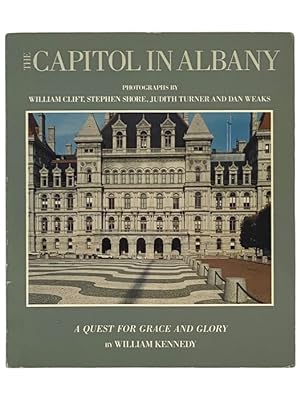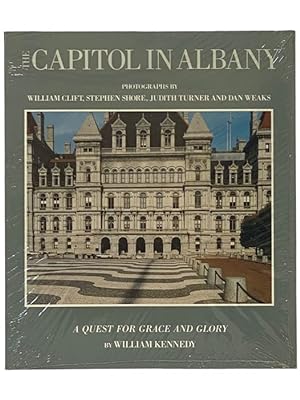aperture temporary state commission on the restoration of the capitol (2 results)
Product Type
- All Product Types
- Books (2)
- Magazines & Periodicals
- Comics
- Sheet Music
- Art, Prints & Posters
- Photographs
- Maps
- Manuscripts & Paper Collectibles
Condition
Binding
- All Bindings
- Hardcover
- Softcover (2)
Collectible Attributes
- First Edition
- Signed
- Dust Jacket
- Seller-Supplied Images (2)
- Not Print on Demand (2)
Free Shipping
Seller Location
Seller Rating
-
Capitol in Albany: A Quest for Grace and Glory
Published by Aperture / Temporary State Commission on the Restoration of the Capitol, 1986
ISBN 10: 0893812099ISBN 13: 9780893812096
Seller: Yesterday's Muse, ABAA, ILAB, IOBA, Webster, NY, U.S.A.
Book
Soft Cover. Condition: Very Good. Edges a bit rubbed. 1986 Soft Cover. [32 pp.] This book celebrates, through text and numerous color photographs, the construction and modification of the Capitol Building in Albany, with prefaces by Mario M. Cuomo, Warren M. Anderson, & Stanley Fink, as well as an essay by William Kennedy. Known for its vast scale and unique combination of architectural styles, this structure is a wonderful object of study for those interested in architecture. "The unique character New York State's Capitol Building is explored in this volume. Four of America's leading photographers and Albany's leading man of letters throw the spotlight on this little-known landmark. Photographers William Clift, Stephen Shore, Judith Turner, and Dan Weaks turn their camera eye on this historical monument in celebration of its beauty. An introduction by Pulitzer Prize-winning author William Kennedy addresses the Capitol's history and Kennedy's own remembrances of its glory days. A preface by New York Governor Mario Cuomo, Warren M. Anderson, and Stanley Fink sets the tone of loving appreciation. The diverse collection of images herein is a testament not only to the myriad fascinations which the building holds but to the flexibility and varied vocabulary of the photograph. The Capitol in Albany begins with Dan Weak's black-and-white composite photographs of the four facades. Weaks's images offer the most complete view of the Capitol extant, a view unavailable to the human eye from the street. Stephen Shore moves us inward with beautiful color images of the grand stairways that lead to the Capitol's many entrances. Once inside, William Clift photographs the anterooms and meeting rooms, bringing a delicacy of vision to bear on the ghosts of Albany's past. Finally, Judith Turner explores the structural details which distinguish the Capitol, rendering them with the simplicity of charcoal drawing. In all, the Capitol is revealed to be both architecturally significant and rich in history. This volume speaks eloquently and convincingly of the building's beauty and the need for architectural and historical preservation. A landmark work of architecture, the New York State Capitol Building in Albany has been a source of both pride and controversy since its inception in 1866. Like a medieval cathedral -- and unlike most American architecture -- the construction of the building stretched over more than three decades and several changes in popular taste. It bears the creative imprints of a half-dozen architects, and stands today as an amazing amalgam made from the stuff of both dreams and democracy. The Capitol's history began during the Revolutionary War when, fleeing the British, legislators left their home base in New York City, and constantly shifted their meetings from Harlem to Fishkill, Kingston to Poughkeepsie and Albany. As bureaucracy would have it, mountains of paperwork accumulated, forcing the legislature to become less mobile. In 1797 a bill was passed designating Albany the capital. In 1804 it was decided that an official meeting house was needed for these, the most influential decision-makers in the Empire State. The cornerstone for the original capitol building was laid in 1806, on the top of State Street Hill in Albany, with Mayor Philip Schuyler Van Rensselaer in attendance. By 1863, the state government had outgrown its modest quarters several times over, and bigger, more lavish quarters were required. Two years of planning and debate ensued over a new capitol and whether it should be built in Albany. It was decided that it should and the new capitol rose up behind the old one. As lawmakers changed, so did the tastemakers--and the architects they employed. The first round of building was marked by the collaboration of Thomas and Italian Renaissance architecture respectively. In 1876, with a new legislature in place, and financial appropriations wavering accordingly, Gilman withdrew and Fuller was dismissed. They were replaced by an advisory board containi.
-
Capitol in Albany: A Quest for Grace and Glory
Published by Aperture / Temporary State Commission on the Restoration of the Capitol, 1986
ISBN 10: 0893812099ISBN 13: 9780893812096
Seller: Yesterday's Muse, ABAA, ILAB, IOBA, Webster, NY, U.S.A.
Book
Soft Cover. Condition: Fine. Still in original plastic wrap. 1986 Soft Cover. [32 pp.] This book celebrates, through text and numerous color photographs, the construction and modification of the Capitol Building in Albany, with prefaces by Mario M. Cuomo, Warren M. Anderson, & Stanley Fink, as well as an essay by William Kennedy. Known for its vast scale and unique combination of architectural styles, this structure is a wonderful object of study for those interested in architecture. "The unique character New York State's Capitol Building is explored in this volume. Four of America's leading photographers and Albany's leading man of letters throw the spotlight on this little-known landmark. Photographers William Clift, Stephen Shore, Judith Turner, and Dan Weaks turn their camera eye on this historical monument in celebration of its beauty. An introduction by Pulitzer Prize-winning author William Kennedy addresses the Capitol's history and Kennedy's own remembrances of its glory days. A preface by New York Governor Mario Cuomo, Warren M. Anderson, and Stanley Fink sets the tone of loving appreciation. The diverse collection of images herein is a testament not only to the myriad fascinations which the building holds but to the flexibility and varied vocabulary of the photograph. The Capitol in Albany begins with Dan Weak's black-and-white composite photographs of the four facades. Weaks's images offer the most complete view of the Capitol extant, a view unavailable to the human eye from the street. Stephen Shore moves us inward with beautiful color images of the grand stairways that lead to the Capitol's many entrances. Once inside, William Clift photographs the anterooms and meeting rooms, bringing a delicacy of vision to bear on the ghosts of Albany's past. Finally, Judith Turner explores the structural details which distinguish the Capitol, rendering them with the simplicity of charcoal drawing. In all, the Capitol is revealed to be both architecturally significant and rich in history. This volume speaks eloquently and convincingly of the building's beauty and the need for architectural and historical preservation. A landmark work of architecture, the New York State Capitol Building in Albany has been a source of both pride and controversy since its inception in 1866. Like a medieval cathedral -- and unlike most American architecture -- the construction of the building stretched over more than three decades and several changes in popular taste. It bears the creative imprints of a half-dozen architects, and stands today as an amazing amalgam made from the stuff of both dreams and democracy. The Capitol's history began during the Revolutionary War when, fleeing the British, legislators left their home base in New York City, and constantly shifted their meetings from Harlem to Fishkill, Kingston to Poughkeepsie and Albany. As bureaucracy would have it, mountains of paperwork accumulated, forcing the legislature to become less mobile. In 1797 a bill was passed designating Albany the capital. In 1804 it was decided that an official meeting house was needed for these, the most influential decision-makers in the Empire State. The cornerstone for the original capitol building was laid in 1806, on the top of State Street Hill in Albany, with Mayor Philip Schuyler Van Rensselaer in attendance. By 1863, the state government had outgrown its modest quarters several times over, and bigger, more lavish quarters were required. Two years of planning and debate ensued over a new capitol and whether it should be built in Albany. It was decided that it should and the new capitol rose up behind the old one. As lawmakers changed, so did the tastemakers--and the architects they employed. The first round of building was marked by the collaboration of Thomas and Italian Renaissance architecture respectively. In 1876, with a new legislature in place, and financial appropriations wavering accordingly, Gilman withdrew and Fuller was dismissed. They were replaced by an advisory bo.



